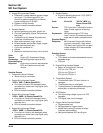
5B.34
Section 5B
EFI Fuel System
Fuel System
WARNING: Fuel System Under Pressure!
The fuel system operates under high pressure. System
pressure must be relieved through the test valve in the
fuel rail prior to servicing or removing any fuel system
components. Do not smoke or work near heaters or
other fire hazards. Have a fire extinguisher handy and
work only in a well-ventilated area.
The function of the fuel system is to provide sufficient
delivery of fuel at the system operating pressure of 39
psi ± 3. If an engine starts hard, or turns over but will
not start, it may indicate a problem with the EFI fuel
system. A quick test will verify if the system is
operating.
1. Disconnect and ground the spark plug leads.
2. Complete all safety interlock requirements and
crank the engine for approximately 3 seconds.
3. Remove the spark plugs and check for fuel at the
tips.
a. If there is fuel at the tips of the spark plugs,
the fuel pump and injectors are operating.
b. If there is no fuel at the tips of the spark plugs,
check the following:
1. Make sure the fuel tank contains clean,
fresh, proper fuel.
2. Make sure that vent in fuel tank is open.
3. Make sure fuel tank valve (if so equipped)
is fully opened.
4. Make sure battery is supplying proper
voltage.
5. Check that the fuses are good, and that all
electrical and fuel line connections are
good.
6. Test fuel pump and relay operation as
described earlier under ‘‘Fuel Pump –
Service.’’
Fault Codes
The ECU continuously monitors engine operation
against preset performance limits. If the operation is
outside the limits, the ECU activates the MIL and
stores a diagnostic code in its fault memory. If the
component or system returns to proper function, the
ECU will eventually self-clear the fault code and turn
off the MIL. If the MIL stays illuminated, it warns the
customer that dealer service is required. Upon receipt,
the dealer technician can access the fault code(s) to
help determine what portion of the system is
malfunctioning. The 2-digit blink codes available
based upon the style of ECU are listed on pages
5B.35-5B.36.
The codes are accessed through the key switch and
displayed as blinks or flashes of the MIL. Access the
codes as follows.
1. Start with the key switch off.
2. Turn the key switch on-off-on-off-on, leaving it on
in the third sequence. The time between
sequences must be less than 2.5 seconds.
3. Any stored fault codes will then be displayed as a
series of MIL blinks (from 2 to 6) representing the
first digit, followed by a pause, and another series
of blinks (from 1 to 6) for the second digit (see
Figure 5B-43).
a. It’s a good idea to write down the codes as
they appear, as they may not be in numerical
sequence.
b. Code 61 will always be the last code
displayed, indicating the end of code
transmission. If code 61 appears immediately,
no other fault codes are present.


















